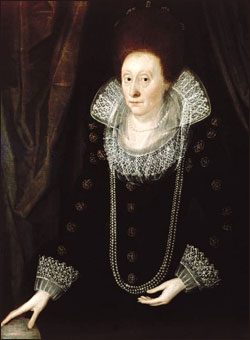 |
| Bebbe Grillo |
 |
| Queen Elizabeth, c.1600. Artist Unknown. City Museum, Plymouth |
"... A new mint was built. England’s coins had been greatly debased by the time Elizabeth came to power. She recalled all the old coins to be reminted, after which the face value of the coins corresponded with it’s true silver content. The new mint was built near the Salt Tower, which was between the inner and outer walls. She also built two refining houses one was at Coldwater Gate within the Tower and their other just outside the tower walls in East Smithfield.

Sonnet Sequences & Social Distinctions in Renaissance England<ContinueClick
 |
| Shakespeares Made In Canada<Click |
Four Periods of Shakespeare's Life
From Halleck's New English Literature by Reuben Post Halleck. New York: American Book Company, 1913.
We may make another classification from a different point of view, according to the period of his development at the time of writing special plays. In order to study his growth and changing ideals, it will assist us to divide his work into four periods.
(1) There was the sanguine period, showing the exuberance of youthful love and imagination. Among the plays that are typical of these years are The Comedy of Errors, A Midsummer Night's Dream, Romeo and Juliet, Richard II and Richard III. These were probably all composed before 1595.
(2) The second period, from 1595 to 1601, shows progress in dramatic art. There is less exaggeration, more real power, and a deeper insight into human nature. There appears in his philosophy a vein of sadness, such as we find in the sayings of Jaques in As You Like It, and more appreciation of the growth of character, typified by his treatment of Orlando and Adam in the same play. Among the plays of this period are The Merchant of Venice, Henry IV, Henry V, and As You Like It.
(3) We may characterize the third period, from 1601 to 1608, as one in which he felt that the time was out of joint, that life was a fitful fever. His father died in 1601, after great disappointments. His best friends suffered what he calls, in Hamlet, "the slings and arrows of outrageous fortune." In 1601 Elizabeth executed the Earl of Essex for treason, and on the same charge threw the Earl of Southampton into the Tower. Even Shakespeare himself may have been suspected. The great plays of this period are tragedies, among which we may instance Julius Caesar, Hamlet, Othello, Macbeth, and King Lear.
(4) The plays of his fourth period, 1608-1613, are remarkable for calm strength and sweetness. The fierceness of Othello and Macbeth is left behind. In 1608 Shakespeare's mother died. Her death and the vivid recollection of her kindness and love may have been strong factors in causing him to look on life with kindlier eyes. The greatest plays of this period are Cymbeline, The Winter's Tale, and The Tempest.
Shakespeare-online.com/biography/fourperiods<ContinueClick
No comments:
Post a Comment